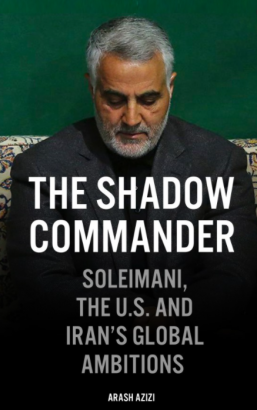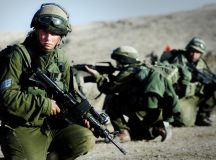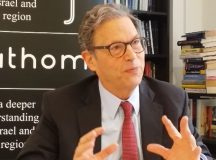A little over a year ago, U.S. President Donald Trump gave the order to kill Qassem Soleimani, the de facto deputy leader of Iran. Arash Azizi’s The Shadow Commander: Soleimani, the U.S., and Iran’s Global Ambitions is an effort to explain who Soleimani was, how he rose to controlling the lives of millions of people well outside the borders of Iran, and how in the end he was brought down.
Early Years
Soleimani was born in the small village of Qanat Molk, in the Kerman province of Iran, in 1957, during the Cold War, the crucial context for the 1978-79 Islamic Revolution. ‘Although his opponents would come to caricature him in that way, the Shah [King of Iran] was no corrupt and nasty Cold War dictator like François Duvalier or Ferdinand Marcos’, Azizi notes, though his brief rendition of the Mohammed Mossadeq episode is less nuanced. To refer to the period 1941-53 as ‘Iran’s twelve-year experience of democracy’ is a stretch, historical and lexicographical.
Soleimani’s father benefited from the Shah’s land reforms, but acquired debt – a source of shame in Iran. Qassem did much less complicatedly well by the Shah’s state: finishing school and being given a job with steady income in the Kerman water organisation in 1975, aged 18. This involved Soleimani’s move to the city of Kerman. Hardly Tehran, it was still a major change for a young man from a ‘little village where even electricity was a luxury’.
The Islamic Revolution re-wrote this period as one of misery and repression. The truth is ‘[t]he 1970s were an exhilarating time’, writes Azizi. This was the height of Iran’s economic growth under the Shah; the cultural scene was vibrant, even in a conservative place like Kerman.
Azizi speculates most plausibly that young Qassem sampled what urban Iran in the 1970s had to offer; hagiographical accounts say only that Soleimani got a black belt in karate, which he probably did not, though he certainly excelled in the gym and at martial arts, spaces where any inadequacy he felt at being the villager around the city folk evaporated.
Whether or not Soleimani was giving in to urban temptations of 1970s Iran, he was finding his way to the mosque more, following the lead of his cousin, Ahmad, who had accompanied him to the city. Kerman’s leading revolutionary clergy, loyalists of the then-exiled Ayatollah Ruhollah Khomeini, like Ayatollahs Ali Movahedi-Kermani and Akbar Hashemi Rafsanjani, were restrained by SAVAK, the Shah’s political police.
It was an out-of-town cleric and hojatoleslam (less senior than an ayatollah), Reza Kamyab, a disciple of Ali Shariati and less well-known to the security services, who got through to Soleimani, apparently with a sermon during Ramadan (August-September) 1977, though the ‘revolutionary struggles’ Soleimani claims this instigated are not clear; he seems to have ‘been mostly focused on his job and his love for karate’ during the Revolution, Azizi notes.
Azizi’s analysis of the nature of the Revolution that, as he puts it, helped make Soleimani, even if Soleimani ‘had not helped make the revolution’, is open to challenge. Azizi rather too easily accepts the idea that the Revolution was an affair of the dispossessed, for example, and it is strange to mention that religious minorities ‘worry’ during a moment of upheaval — and to specifically mention Iran’s Jews — then to fail to mention how central an animating idea antisemitism was to the revolutionary clergy, who promptly expelled ninety per cent of Persian Jewry after they were in power.
Countdown to War
Azizi’s section documenting the lead-in to the Iran-Iraq War is excellent. One of the great set-piece scenes he gives is the meeting in September 1979 between Khomeini’s foreign minister Ebrahim Yazdi, one of the English-fluent fanatics who had sold the Revolution to the West as a democratic movement, and Saddam Husayn, who just months earlier has openly taken sole charge of Iraq with his sadistic purge. Iran’s Shi’a Islamists had thought Saddam ‘stood on the right side of history’, Azizi notes, at least while he paid them, even if he did savagely repress their Iraqi co-religionists.
This was all to change. Khomeini’s men felt Saddam’s enthusiasm for their revolution was insufficient; Saddam disliked their meddling in Iraqi politics. Relations basically collapsed in April 1980 after the nearly-year-old Khomeini-inspired disturbances inside Iraq led to an assassination attempt on Tariq Aziz and Saddam retaliated by murdering Khomeini’s leading Iraqi ally, Grand Ayatollah Muhammad Baqir al-Sadr, and his sister. Khomeini responded with open calls for rebellion against Saddam.
Azizi says this was the moment Khomeini confirmed his Revolution would not be confined within Iran’s borders, and in a public sense that is true. But by this time, Khomeini’s Revolution was already in Lebanon in the form of Hezbollah, an entity that Azizi grants rather more autonomy than it claims for itself. In September 1980, Saddam invaded Iran.
The ‘Sacred Defence’
Soleimani joined the Islamic Revolutionary Guards Corps (IRGC) in May 1980, not knowing much about religion or politics, according to Azizi, and the mass mobilisation to defend against Saddam’s attack brought in many more like Soleimani for what the Iranian regime calls the ‘Sacred Defence’.
Soleimani, who began the war guarding the provincial airport in Kerman, was at the front by 1981. ‘Soleimani’s physical prowess made him stand out’, Azizi notes. ‘Many of the revolution’s supporters were armchair revolutionaries, scrawny young men or clerics who had spent a lifetime preaching.’ At 24-years-old, Soleimani had been talent-spotted by IRGC, and now their instructors — nearly all of them trained by the Palestine Liberation Organisation (PLO) at its camps in Lebanon — ensured he was ideologically sound.
The lessons Soleimani learned in the trenches in the 1980s would stay with him ever-afterwards, as did many of the personal connections he made. Azizi has a detailed description of Soleimani’s role in the war as he advanced through the ranks, and gives an overview of the related, concurrent war in Lebanon.
Under the cover of the war, which by 1982 was fought on Iraqi territory as Khomeini tried to spread the Revolution to Baghdad, dissidents were murdered by their thousands and the Islamic Republic was consolidated. Finally, in July 1988, Khomeini agreed to call off the war and eleven months later — after his infamous fatwa against Salman Rushdie — the old man was dead.
Post-War and the 1990s
Rafsanjani engineered Ali Khamenei’s succession as Supreme Leader and tried to do reconstruction via a more technocratic civilian government and reining in the IRGC. Whatever successes Rafsanjani had with the former, he failed at the latter. The IRGC, on the back of a Dolchstoss legend about corrupt clerics behind the lines, built itself into a powerful social, economic, and political force, instilling the Revolution in a new generation.
For Soleimani, the 1990s saw him return home to battle the destabilising drug traders and associated banditry that crossed into Iran from Afghanistan and Pakistan. It was brutal. ‘In Balochistan, I feel like I am back in the war,’ many remember Soleimani saying. A local, and a war hero, Soleimani had the knowledge and standing to do better than others, bringing marked improvements in order.
On 25 January 1998, Soleimani was appointed as head of the Quds Force, a shadowy external division of IRGC created a decade earlier at the end of the war. ‘The Supreme Leader had just made the most consequential appointment of his life’, as Azizi notes.
9/11 and Beyond
Azizi’s recounting of the dawn of the ‘War on Terror’, with references to Bernard Lewis and ‘neocons’, presents Iran as cooperative over Afghanistan, only to be spurned by David Frum’s ‘Axis of Evil’ speech. Azizi at least concedes that the speech alone was not the crux of matters, but the significance of Iran’s long relationship with Al-Qaeda is directly denied. When it comes to Iraq, there are references to President George Bush waging a ‘crusade-like battle’ and his administration being staffed with people ‘who believed as zealously in spreading their ideas as the Iranian revolutionaries’.
Azizi’s thesis of possible US-Iranian rapprochement hinges on the Reformist president Muhammad Khatami. So, it is odd that he should conclude: ‘As it turned out, Khatami had no interest in seriously transforming the Islamic Republic.’ All pretence was stripped away with the installation of Mahmud Ahmadinejad as president, his cabinet half-composed of IRGC officials. The Quds Force would now ‘take over embassies in the region’.
The Quds Force had tested its capacity to export the Revolution in Bosnia and Afghanistan in the 1990s and, with Saddam gone, turned to Iraq. The Badr Corps, created from Iraqis who crossed to the other side during the war with Saddam, was a key instrument. Badr was the seedbed for the other Shi’a militias, with the notable exception of Muqtada al-Sadr’s Mahdi Army, though even that was brought under Soleimani’s effective control. Azizi also points to things like the Centre for Restoration of the Sublime Gates (CRSG), a body ostensibly engaged in refurbishing and protecting Shi’a shrines, which was in fact ‘a unit of the Quds Force … soon earning the nickname ‘Soleimanis in suits’.’
Under Soleimani, Iran developed its ‘Axis of Resistance’, which formally included Sunni militant groups like Hamas, and within its orbit were factions like the Patriotic Union of Kurdistan (PUK). Nonetheless, over time ‘the power and logic of Shia sectarianism [became] a much more powerful organising principle’ even than ‘anti-Zionism’.
This dynamic was reinforced by the precursors of the Islamic State (ISIS), expressing an undisguised, genocidal hatred of Shi’is, annexing the Sunni insurgency in Iraq. Azizi notes that Iran also found objective common cause with ISIS by ‘not stand[ing] in the way’ of attacks on Coalition forces. He could have gone further.
In 2006, Soleimani had taunted the American commander in Iraq: ‘I hope you have been enjoying the peace and quiet in Baghdad. I’ve been busy in Beirut!’ Soleimani was referring to the war Hezbollah had waged that summer against Israel. ‘Stories went around of [Soleimani] having breakfast in Beirut, lunch in Damascus, and dinner in Baghdad’, Azizi notes. Exaggeration it might have been, the unified transnational terrorist infrastructure was very real, and Soleimani was a hands-on manager. Iran’s aspirations never ceased to be global, either, with terrorist plots and operations from Washington, D.C., to Bulgaria against America and Israel.
The Arab Spring and the Rise of ISIS
The last third or so of the book is devoted to the interlocking issues of Iran’s response to the Arab spring after 2011, particularly its movement of tens of thousands of Shi’a jihadists under Soleimani’s command into Syria and working with the Russians to protect the regime of Bashar al-Assad; the nuclear negotiations with the US to reach the Joint Comprehensive Plan of Action (JCPOA); and the war against ISIS after it overran large chunks of Iraq and Syria and declared its ‘caliphate’ in 2014. In all of these matters, Soleimani was at the centre, and when chances were offered by this new landscape — in Yemen, or for renewed outreach to the Muslim Brotherhood — that was Soleimani’s domain, too.
Azizi brilliantly describes the way the West compartmentalised on the nuclear and regional files — while Iran never did, using advances on one front to buy concessions on the other. This became even more blatant after the Iraqi security forces collapsed and ISIS grabbed its statelet. Soleimani had matched ‘[ISIS’s] murderous sectarianism with a version of his own’, Azizi notes, and in so doing prepared the political ground in Iraq that made the ISIS mess possible. Now he would extract a price to clean up.
With the US unwilling to put its own forces on the ground in any appreciable numbers, Soleimani’s foreign jihadist legions — the very same militias that had killed nearly as many Coalition troops as ISIS, augmented with Shi’i recruits from Afghanistan to the Ivory Coast — were deputised, able to vastly expand Iran’s Empire under Coalition air power. This Iranian ‘help’ was to be paid for at the nuclear negotiating table. An ‘amicable modus operandi [was] taking shape between the Islamic Republic and the Great Satan’, Azizi notes wryly.
Soleimani’s habit of being at the front — and being photographed there — propelled him to stardom by 2015, not only in Iran but I n the world’s press, and, in July 2015, Soleimani was received in the Kremlin to plan for Russia’s direct intervention in Syria to rescue the Assad regime for a second time. The Russians have nothing but contempt for Assad’s army, but they respected Soleimani (and Hezbollah). For IRGC-loyal Shi’a fighters, stories abounded that cemented the cult and mystique around Soleimani: ‘We heard … Hajji [Qassem] had interrupted the meeting to say his prayers right there. This was Moscow! The centre of atheism.’
Shortly after President Trump came into office, Soleimani consolidated in Syria, preventing the US displacing ISIS with any kind of bridgehead to challenge the Assad/Iran system. This was Soleimani at the height of his power — and hubris. Despite Trump pulling the US out of the JCPOA in May 2018 and instituting the ‘maximum pressure’ sanctions campaign, Soleimani would remain on top, unchallenged where it mattered, on the ground in the region.
Azizi concludes by noting the next stage would almost certainly have been a run in domestic politics in Iran. Gone was the self-effacing and almost mocking stock response whenever asked about a run for the presidency; now the message was telegraphed that he could renew the Revolution at home in the way he had abroad. But it was not to be.
Soleimani was no longer the ‘shadow commander’; he had stepped into the spotlight on a global scale. The same brashness that had raised Soleimani up, vindicating his decision to double-down and hold his nerve in Syria when there were doubts even within the Iranian elite, would now bring him down.
Despite all the American blood on his hands, Soleimani felt safe landing in Baghdad, one of the most American-surveilled cities in the world, with only cursory security. ‘America can’t do a damn thing’, Khomeini had said, and in Soleimani’s experience they had been even worse, abetting his imperialism and feeling grateful for the privilege. But he had staged one provocation too many, messing around with the American Embassy in Baghdad and triggering memories of the 1979 Tehran Embassy siege in a President unclear on the concept of restraint. Azizi finishes by noting that Soleimani’s successor has not and cannot measure up to Soleimani.





































